In 2010 I published the chapter ´08.17. Aether-Vortex of the Earth´. There was stated, the geostationary satellites won´t keep their places above the equator, but each day they are dancing at strange tracks, depending on their equatorial location. These motions can not to explain by common understanding of attracting forces of the sun and the earth. However these ´phenomena´ are easy to grasp by considerations about aether-whirlpools around the sun and the earth - thus giving clear evidence for the existence of the aether.
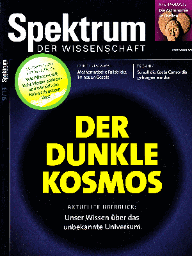 I asked professionals to check the track-data of these satellites, so they could convince themselves why the common understanding of gravity can´t be correct. As usual, no answer arrived from the addressed specialists. The newspaper ´Spectrum of Sciences´ reported comprehensive the momentary knowledge about the ´Dark-Cosmos´ in September 2013. This was the motive for discussing the problems about geostationary satellites once more, at the following at first conform to prevailing doctrine.
I asked professionals to check the track-data of these satellites, so they could convince themselves why the common understanding of gravity can´t be correct. As usual, no answer arrived from the addressed specialists. The newspaper ´Spectrum of Sciences´ reported comprehensive the momentary knowledge about the ´Dark-Cosmos´ in September 2013. This was the motive for discussing the problems about geostationary satellites once more, at the following at first conform to prevailing doctrine.
Known Data of Track
At picture 08.22.01 upside left, the data of the earth (E, blue) are marked when turning around the sun (S, yellow). At the perihelion the distance between earth and sun is about 147100000 km, at the aphelion the distance is some longer with 152100000 km. So the elliptical track differs by some +/- 1.6 % from the average distance of about 150 million kilometer (see data upside at the green face). At the perihelion the earth moves rather fast with 30.29 km/s, at the aphelion some slower by 29.29 km/s. So the divergence to the average velocity of some 30 km/s again is about 1.6 % (see data below at the green face).
Right upside of that picture, the relevant data of geostationary satellites (GS) are marked. The radius of the earth (E, blue) is about 6378 km. At height of 35786 km the satellites are turning, one revolution each day, thus synchronous to the rotation of the earth. At this distance of exact 42164 km from the centre of the earth, they move by exact 3.073 km/s. Based on inertia-´force´ (TK) they tend to move straight off tangentially. At previous conditions, the centripetal attracting force (AK) of the earth is exactly able to draw the satellites continuously at a circled track.
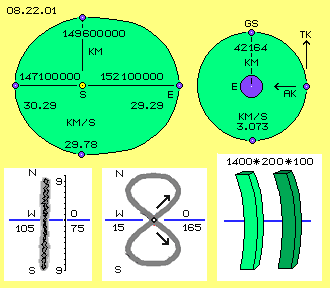 Divergent Satellite-Tracks
Divergent Satellite-Tracks
The satellites however stand not constant above the equator. Each day they are walking once up to the north, back down crossing the equator towards south and back again to their original position. This journey takes ´only some hundred kilometer´, however differing from the equator up to nine degree. When a satellite exactly stands upon the equator at sunrise and/or sunset, it will move up and down at a straight line (see picture left below). If a satellite exactly stands upon the equator at midday and/or midnight, it will move at an 8-shaped track (see picture at the middle below). Strange enough previous curves won´t come up exact at mentioned positions (6- and 18-o´clock respective 0- and 12-o´clock), but one hour late (105-degree-west and 75-degree-east respective 15-degree-west and 165-degree-east). At all other positions above the equator, the curves are ´smeared´.
The operating companies are obliged to keep their geo-stationary (or geo-synchronous) satellites within a ´box´ of some 1400/200/100 km (space marked light green in the picture right below). In order to keep the satellites within their box, occasionally they must be re-directed. Shifting into west/east-directions makes no problems. That swinging into north/south-direction however, practically is not to prevent. The fuel is finished after ten or fifteen years. The burnt-out satellites finally are shifted some 300 km higher into a ´graveyard-area´ (dark-green right side below) - where they go on dancing on and on.
Vaulting Point
Picture 08.22.02 upside right shows a wheel (green), rotating around its stationary axle (A). There are marked two mass-points (B and C), moving at circled tracks within the space. Based on inertia, they want to fly off tangentially. They show likely angle-speed, however different absolute velocities and thus also differing centrifugal forces. The spokes of that wheel thus continuously are forced to perform centripetal force of attraction (according to formula a=v^2/r).
At this picture left upside, now the wheel is steady rolling towards left side at the ground (grey). The tracks of observed mass-points now show quite different characteristics. The mass-point (C, red) at the rim of the wheel is ´jumping´ forward at a wide bow (red curve). At the support-point it´s stationary resting for a short moment. Then it´s sharply accelerated diagonal-upward (see distance between the red points). Upside it´s moving double as fast as the hub (A, grey). Finally it´s decelerated and pushed down to the next support-position. The inertia shows into varying directions. Based on changing velocity the spoke now must perform quit different ´forces of attraction´.
At same spoke, however near to the axle, the second mass-point (B, blue) is located, now moving forward at a wave-shaped track. Upside of the hub it´s moving relative fast, below the hub it´s moving corresponding slower. It´s moving parallel to the hub only at two positions, most upside and most below. Generally its inertia is showing forward all times, alternating some up and down. The spoke thus is not weighed by constant centrifugal forces, but by different pulling-forces into varying directions. All in all, the forces coming up at the stationary rotating wheel and at the rolling wheel are ´different like day and night´.
Like Day and Night
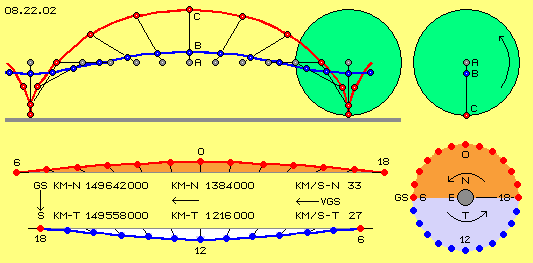 At this picture right side below, the ´wheel´ of the earth (E, grey) is sketched. Synchronous to its rotation, the geostationary satellites (GS) are guided at circled tracks by the ´invisible spoke of attracting gravity-force´. At this picture, the sun is positioned far below. The positions of satellites at the ´night-half´ (N) are marked red, at ´day-side´ (T) they are marked blue.
At this picture right side below, the ´wheel´ of the earth (E, grey) is sketched. Synchronous to its rotation, the geostationary satellites (GS) are guided at circled tracks by the ´invisible spoke of attracting gravity-force´. At this picture, the sun is positioned far below. The positions of satellites at the ´night-half´ (N) are marked red, at ´day-side´ (T) they are marked blue.
At this picture, the earth is moving from right to left, each day about one degree forward around the sun. Here simplistic is assumed, that short section of track is linear. At 18-o´clock-position, the satellite lags behind the earth. At the night-half it overcomes the earth around the back. At the 6-o´clock-position it´s running ahead of the earth. Afterward the earth is overtaking the satellite, which comes most near to the sun at 12-o´clock-position. At evening, the satellite falls back to next 18-o´clock-position
Left side below at this picture, both motions are combined, thus the rotation of satellites around the earth plus the (linear) forward-motion towards left of the earth. The red track-section of the night-half (18-0-6-o´clock) is marked upside, below the blue track of the day-half (6-12-18-o´clock) is sketched. Both track-sections as a whole are similar to the track of the mass-point B of previous wheel-example. The relation of lengths at this drawing is true to scale. Some relevant data are marked.
Fast and long / slow and short
The average distance between earth and sun is about 150 million kilometer. These plus/minus 42000 km between satellites and sun can be ignored (1/3571). The earth moves forward about 2600000 km every day, thus some 1.3 million kilometer within 12 hours. From 18- to 6-o´clock the satellite is moving two times these 42000 km in addition, i.e. each night-half moving forward by 1384000 km. At day-half it´s flying corresponding less, only about 1216000 km. The difference from the average length of the routes are more than +/- 3%.
The average velocity of the earth are 2600000 km/day, i.e. 108300 km/h respective 30 km/s. During the night, the satellite is overtaking the earth (by view from the sun ´around the back´), moving faster up to 3 km/s. Its velocity at night-half thus can be up to 33 km/s. At the sun-half, the satellite is correspondingly slower, thus moving only by 27 km/s. The differences to the average velocity are up to +/- 10 %, thus most remarkable (realiter the addition should obey the vectors). Generally, the satellite is flying a long distance relative fast through the night and at the day it´s ´dawdling´ a relative short way relative slowly. The previous graph shows the obvious difference between the long red and the short blue phase.
Velocity and Direction
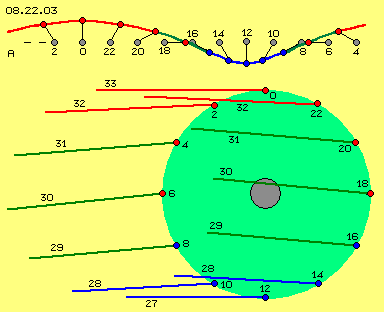 At picture 08.22.03 upside, the wave-shaped track is sketched once more (where the amplitude is overdrawn). Diverse positions of the satellite are marked, each two hours, from 4-o´clock to 2-o´clock. This indicates the different velocities (distances between the points) and directions the satellite is momentary flying: fast at the upside section (red), accelerated and decelerated within the transition-areas (green), slow at the section below (blue). The black ´spoke´ between satellite and the earth (grey) indicates the direction of the affecting earth-gravity.
At picture 08.22.03 upside, the wave-shaped track is sketched once more (where the amplitude is overdrawn). Diverse positions of the satellite are marked, each two hours, from 4-o´clock to 2-o´clock. This indicates the different velocities (distances between the points) and directions the satellite is momentary flying: fast at the upside section (red), accelerated and decelerated within the transition-areas (green), slow at the section below (blue). The black ´spoke´ between satellite and the earth (grey) indicates the direction of the affecting earth-gravity.
Below at this picture, the direction and velocity of the satellite at each position is marked by larger scale. For example one can see how the earth is pulling down the satellite from 4-o´clock to 8-o´clock and same time it´s decelerated from about 31 km/s to 29 km/s. At 12-o´clock the satellite is flying parallel to the earth for a short moment, however only with some 27 km/s. Afterward, the satellite is flying behind the earth. The force of gravity pulls upward the satellite and it becomes accelerated up to 33 km/s at midnight. The satellite must move into these directions by these velocities for running synchronous around the earth, which by itself is flying around the sun by speed of 30 km/s.
Inertia and Gravity-Forces
Based on common understanding, this process is achieved by cooperation of two gravity-systems. At picture 08.22.04 left side is sketched, the earth (grey) and also the geostationary satellites (red) are moving forward by about 30 km/s. The length of grey lines represent this speed respective the resulting inertia-´force´ TK 30. The attracting power (AS 30) of the sun (far down below that picture) is just as strong to force the earth- and satellite-masses into a circled track. The masses of the earth and the satellites are so small in comparison with the sun-mass, so they can be ignored. The average distance between sun and earth are about 1.5 million kilometer, so also that small difference of +/- 42000 km can be ignored.
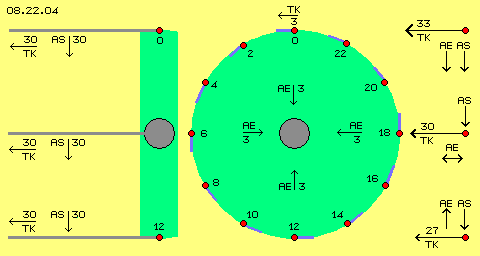 At the middle of that picture, the second gravity-system is sketched: around the earth (grey) the satellites are rotating by about 3.0 km/s. The blue lines represent this speed respective the resulting inertia-force TK 3. At the distance of about 42000 km, the centripetal attracting force of the earth (AE 3) is exact strong enough to pull the satellites continuously into a circle track.
At the middle of that picture, the second gravity-system is sketched: around the earth (grey) the satellites are rotating by about 3.0 km/s. The blue lines represent this speed respective the resulting inertia-force TK 3. At the distance of about 42000 km, the centripetal attracting force of the earth (AE 3) is exact strong enough to pull the satellites continuously into a circle track.
Right side of that picture, the cooperation of both attracting forces is marked for three positions. At the most outside point of the track (upside, 0-o´clock) the combined forces of the earth (AE) and the sun (AS) are pulling the satellite towards the sun. At middle positions (at 6-o´clock respective 18-o´clock) only the sun (AS) is pulling the satellites down. The attracting force of the earth (AE) affects radial, thus accelerating / decelerating the forward-motion of the satellites (see double-arrows). At the position below (12-o´clock) both forces act into contrary directions: at the one hand the satellite is pulled down towards the sun (AS), same time it is pulled up by the earth-gravity (AE). At all other positions, both forces add corresponding to the vectors.
Effect of Sun-Gravity
Picture 08.22.05 shows the effect of sun-force onto the satellites, left side at first the interaction between inertia and gravity. The attracting force (AS 30) corresponds to the average velocity of the earth with its 30 km/s and thus also to the satellites cross to the earth (6-o´clock and 18-o´clock). At its outmost position (0-o´clock) the satellite shows longer distance to the sun, what can be ignored. There it moves by 33 km/s, thus one tenth faster, a fact not to ignore. The kinetic energy and the inertia, the centrifugal force and the demanded centripetal force rise with the square of velocity, so that 30:33 becomes a relation of 900:1089, resulting a factor of 1.2. So the sun will hardly be able to keep the satellite on the demanded track at its utmost position.
If opposite, the satellite come near to the sun (12-o´clock, left side below), the velocity is only 27 km/s, resulting a factor of 0.8 for involved forces. The sun will draw-near stronger that satellite which is momentary much ´too slow´. Remember: the velocity of the earth differs at the perihelion and the aphelion only by 1.6 % from the average. The sun needs one year to compensate this by an elliptical track. So the sun will hardly be able to compensate the enormous acceleration and deceleration of the satellite every day.
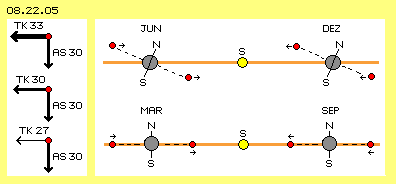 At this picture upside right, a cross-sectional view through the ecliptic (red line) is sketched. Left side, the axle of the earth (N-S) is inclined like at North-summer (JUN). The gravity-force of the sun (S, yellow) will pull the satellites towards North all times (see arrows). Opposite, at North-winter (upside right, DEZ) the satellites would be pulled southward all times. Thus only once a year, the satellites would wander towards North respective South - while the satellites really perform that journey every day.
At this picture upside right, a cross-sectional view through the ecliptic (red line) is sketched. Left side, the axle of the earth (N-S) is inclined like at North-summer (JUN). The gravity-force of the sun (S, yellow) will pull the satellites towards North all times (see arrows). Opposite, at North-winter (upside right, DEZ) the satellites would be pulled southward all times. Thus only once a year, the satellites would wander towards North respective South - while the satellites really perform that journey every day.
Right side below, the positions correspond to spring and fall (MAR and SEP). If the satellites there would rotate at the equatorial plane, they are not pushed to the North or South. When they move towards the sun (0-o´clock to 12-o´clock), they would be accelerated, thus would run ahead towards East. Opposite at afternoon and evening, when they move back to the midnight-position, the gravity force of the sun would decelerate that motion. This would be valid for all satellites upon the equator. In reality however, that West-East-motion comes up only at certain positions. So the gravity of the sun can not cause the real inevitable ´dance of satellites´. Opposite: with regard to the velocity-differences the satellites would soon tumble around pretty chaotic.
Effect of Earth-Gravity
Picture 08.22.06 right side schematically shows the cooperation of both gravity-forces. The blue lines are drawn radial towards the earth and they represent their attracting force (AE 3). The grey lines are directed vertically down and they represent the attracting force (AS 30) of the sun. The red lines show the directions whereto the satellites must move at each position.
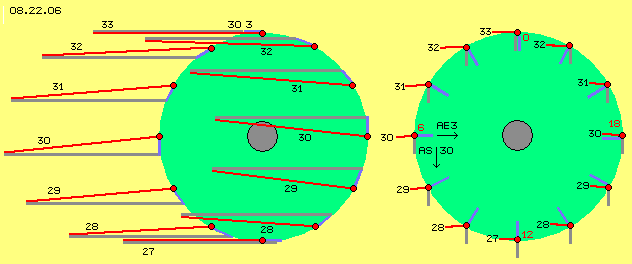 At the left positions (from 12- via 18- to 0-o´clock) they show upward. There must occur acceleration (from 27 up to 33 km/s), so the satellite can overtake the earth around its back. However just there, the sun-gravity affects decelerating (as the resulting force shows down-left). Opposite, the speed of satellite at the left positions (from 0- via 6- to 12-o´clock) must be delayed, so now the earth can overtake the satellite. Here however, the sun will pull forward the satellite, thus will result an acceleration-effect.
At the left positions (from 12- via 18- to 0-o´clock) they show upward. There must occur acceleration (from 27 up to 33 km/s), so the satellite can overtake the earth around its back. However just there, the sun-gravity affects decelerating (as the resulting force shows down-left). Opposite, the speed of satellite at the left positions (from 0- via 6- to 12-o´clock) must be delayed, so now the earth can overtake the satellite. Here however, the sun will pull forward the satellite, thus will result an acceleration-effect.
The attracting force of the earth at height of the satellites is just so strong to redirect a body of 3 km/s velocity from its tangential direction into a circled track. That tangential direction however exists only at two positions (at 12- and 0-o´clock). At all other positions, the satellites fly into other directions. There the attraction works only by the vector-part. The speed of satellites nowhere is 3 km/s, but ten times faster (with 27 to 33 km/s). The inertia thus is 100-fold stronger. So the attracting force of the earth will never be able to force the satellites into the demanded track. Everybody may think over the monstrousness of that miscalculation.
Left side at this picture, the satellites are drawn once more and the blue lines represent their circle-motion around the earth. The grey lines represent their forward-motion around the sun. This motion is simply drawn as a straight line. The red lines represent the resulting motions - just like geostationary satellites must move within space. So the wave-track is not based on the cooperation of the gravity-forces of the earth and the sun - but simply is the result of two overlaying circle-´flows´.
So the known deduction of the necessary radius for geostationary satellites is based only at the mode and formula of a ´wheel´ rotating around a stationary axle. The totally different inertia-forces of the additional forward-motion is just ignored. The calculation is made up completely false, and it won´t become better by somehow fitting results (see below).
Thrust in Misunderstanding
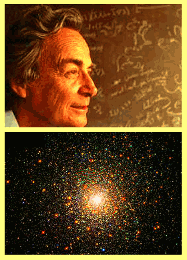 The believe, one could grasp all functions of the universe into one formula is a misconception. Unfortunately the mathematics play a dominant role at most subjects of sciences, however no formula could ever explain the real essence of an occurrence. Seemingly right results of calculations are worthless, because they are based on a set of factors, which as a rule are defined by circular reasoning. Only if the variety of nature-appearances and the ´essence of live´ is disregarded, one can build ´nature-scientific´ simple formula - and even then will happen grave mistakes.
The believe, one could grasp all functions of the universe into one formula is a misconception. Unfortunately the mathematics play a dominant role at most subjects of sciences, however no formula could ever explain the real essence of an occurrence. Seemingly right results of calculations are worthless, because they are based on a set of factors, which as a rule are defined by circular reasoning. Only if the variety of nature-appearances and the ´essence of live´ is disregarded, one can build ´nature-scientific´ simple formula - and even then will happen grave mistakes.
For example, Richard Feynman was a great physicist and he stated often, one can talk only about models however the reality could function quite different. At his famous lecture about gravity, ´he looked deferentially towards the nature, which follows with perfection and universal validity an ingenious simple law like that of gravity: F=G*m1*m2/r^2´. Some later he goes into raptures by the picture of a star-cluster-galaxy: ´who won´t realize, gravity here is working, has no soul´. Hopefully his soul was not damaged by (too late) insight, these cluster-galaxies mostly do not rotate, thus no centrifugal forces exist as counter-part for mass-attraction - so these star-clusters must implode inexorable. Just likely euphorically he describes his Quantum-Mechanics and why one ´can´t understand this by common logic´. Why he (and his colleagues) laboured under a delusion - see some later.
Attraction? Forget it!
Gravity is the most weak ´nature force´ - and just this should be able to affect far by light-years? Previous example did show which inconsistencies come up. The ´strong nuclear force´ is assumed to be the most mighty nature force - and should show effects only at minimum radius for holding the atomic nucleus together? The ´weak nuclear force´ should keep together the whole atom - even many electrons (mutually rejecting) are told to run around at crossing tracks. The attraction between negative / positive electric charges is told to be a natural law - even nobody could ever make out a positron. The suction within gases and liquids works not ´attracting´ - but any motion comes up only based on stronger pressure of the environment. The attraction between north- and south-pole of magnets is a classic example - which again functions only by stronger pressure onto the opposite sides. In nature, no remote attraction exists and it´s a miracle how it should function through the nothing of assumed vacuum. All explanations based on attraction-forces contradict logic laws and are mis-interpretations of the ´phenomena´ observed. There is only one solution for this dilemma: forget all about attraction (what´s not easy) and think about plausible alternatives (what´s easy indeed).
I made up many considerations at my ´Aether-Physics´. At part ´08. Something Moving´ the findings were ´tested´ by about hundred phenomena (besides other also with concern to previous satellite-problem). Here I can only discuss some relevant aspects in brief. The statements might seem to be unfounded claims, however each statement is explained comprehensive with many arguments at my website respective at corresponding book.
Aether-Vortices analogue to Water-Whirlpools
The universe does not exist by 95 % Dark Matter and Dark Energy, but by 100 % aether. By coarse analogy one could compare the aether with water-substance. Within waters can exist many swirls and mostly one embedded within the other. Depending on the relation of radius, the rotation-velocity and the turning-sense of overlaying circled motions, most differing tracks come up (e.g. to recognize by drifting stuff within).
 At picture 08.22.08 upside left at A, a motion-system is sketched where a turning movement of radius R1 (green line) exists. There are drawn 24 positions (grey points) during one revolution. Around the grey point, a second turning with radius R2 rotates (red line with red point). Both rotations are left-turning. However the rotation R2 is double as fast than R1 (see circled arrows). The 24 red points mark positions they will take at this wave-shaped track. Within this system could also circle around much ´driftwood´ at analogue tracks. Right upside at B for example, four similar tracks are drawn. All kind of driftwood will stay within the ring marked light-red, will move faster and slower - and no ´attracting forces´ are demanded at all. Analogue exist wave-shaped tracks at the earth: R1 does one revolution each year, R2 of the moon rotates once each month and R2 of geostationary satellites does one revolution day by day.
At picture 08.22.08 upside left at A, a motion-system is sketched where a turning movement of radius R1 (green line) exists. There are drawn 24 positions (grey points) during one revolution. Around the grey point, a second turning with radius R2 rotates (red line with red point). Both rotations are left-turning. However the rotation R2 is double as fast than R1 (see circled arrows). The 24 red points mark positions they will take at this wave-shaped track. Within this system could also circle around much ´driftwood´ at analogue tracks. Right upside at B for example, four similar tracks are drawn. All kind of driftwood will stay within the ring marked light-red, will move faster and slower - and no ´attracting forces´ are demanded at all. Analogue exist wave-shaped tracks at the earth: R1 does one revolution each year, R2 of the moon rotates once each month and R2 of geostationary satellites does one revolution day by day.
At this picture below left at C, a system is drawn with parameters like at A. At the dotted circle (with radius R1) now are marked only 16 positions of the grey points. Here however comes up a quite different track (at the red curve are marked 16 positions of the red point), because R2 here is turning contrary direction to R1 (see circled arrows). Opposite to previous system, most slow motion occurs at the apex (see short distances between red points at left and right side). An acceleration occurs from outside towards the middle and a deceleration from the middle to next apex.
At this picture below right side at D, a likely system is drawn once more. The relation of turning-speeds however is no longer 1 to 2, but now 1 to 1.8. At E, the ´spoke´ from the grey point shows horizontal towards left (to the left apex). At the opposite point (at F) the overlaying rotation is not finished yet. Finally at G the radius-line is pointing straight to the center. So the apex of right side is some late. The following points are marked light-blue and dark-blue and the next apex now is finished finally at H (instead of position at E). Based on this relation of turning-speeds, thus the whole ´bar´ is slowly turning around the center.
Bar-Galaxy
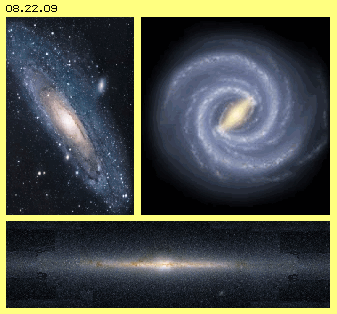 The galaxies mostly are shaped as a ´bar-galaxy´, like picture 08.22.09 shows by different perspectives. Most probably also the Milky Way represents the dynamic of such a system. That ´phenomenal´ appearance is not to explain by common instruments of astronomy - however quit easy by previous motion-pattern. Around the center (by radius R1, clockwise) are turning (at least two) circling flows (by radius R2, anticlockwise), rotating around their own axle (nearby) double as fast. Like a road sweeper they sweep off all drifting stuff to the middle (from the apex inward by increasing speed). So many stars and much dust accumulates within the ´protected´ area of the bar (marked red at previous picture).
The galaxies mostly are shaped as a ´bar-galaxy´, like picture 08.22.09 shows by different perspectives. Most probably also the Milky Way represents the dynamic of such a system. That ´phenomenal´ appearance is not to explain by common instruments of astronomy - however quit easy by previous motion-pattern. Around the center (by radius R1, clockwise) are turning (at least two) circling flows (by radius R2, anticlockwise), rotating around their own axle (nearby) double as fast. Like a road sweeper they sweep off all drifting stuff to the middle (from the apex inward by increasing speed). So many stars and much dust accumulates within the ´protected´ area of the bar (marked red at previous picture).
The areas in front and behind the rotating bar are ´brushed clean´ to a great extend. At the apex of the bar however the road sweeper does not work perfect. From the position near to the centre until next apex, the velocity becomes steady slower. Based on the contrary turning sense, the velocity is minimum direct at the apex. The rotating ´sweep-brush looses much waste´. As the apex goes on moving clockwise within space, a ´band of dirt´ is left behind. That spiral arm is slowly drifting further forward and outward.
So this picture of dynamic movements comes up by flows, which simplistically one could imagine as water-vortices. All ´stable materia´ is drifting within the flows just passive in each directions resulting from the overlay of only two circled motions. The masses are pushed to the centre and ´laid down´ within the bar-area, without any kind of attracting effects. The assembly of stars at the centre won´t do any mass-attraction (otherwise the spiral-arms could not go on drifting slowly outward). There is no need for Dark Matter and there must not exist a Black Hole to compensate the imaginary lag of centripetal forces.
Milky Way
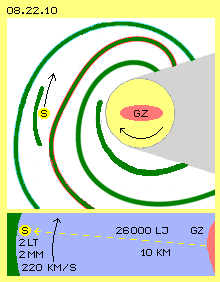 At picture 08.22.10 schematic is drawn, which parts of our galaxy we can see. At the galactic center (GZ) is working that bar (red). At its environment (yellow) are gathered many stars, so the hidden regions behind (grey) can not be observed. Some spiral arms are marked green and the whole system is turning clockwise. At the right side of a spiral arm, the sun-system (S, yellow) is ´rolling´ along anticlockwise.
At picture 08.22.10 schematic is drawn, which parts of our galaxy we can see. At the galactic center (GZ) is working that bar (red). At its environment (yellow) are gathered many stars, so the hidden regions behind (grey) can not be observed. Some spiral arms are marked green and the whole system is turning clockwise. At the right side of a spiral arm, the sun-system (S, yellow) is ´rolling´ along anticlockwise.
The distance to the galactic center are incredible 26000 light-years (LJ), while the light needs just two days (2 LT) to run through total sun-ecliptic. At this picture below, these dimensions are transferred to imaginable scale. At a distance of 10 km we can see the right bank (GZ) of a river, which flows at a right-bended curve. Left hand, we see a band of driftwood and behind, the river is once more as broad. Along that ´spiral arm´ a tiny small water-vortex is rolling forward - with a diameter of just two millimeter.
The sun is racing forward by minimum 220 km/s within space. Against its inertia it should be forced at a circled track, based on the attracting forces of the masses gathered at that remotest galactic center - by common understanding. Everybody may believe in that fairytale. The material masses (which the astronomers assume by 5 %) are practically to ignore, they can not play an active role by effecting imaginary attraction. Their inertia is absolutely negligible in comparison to mass and kinetic energy of the gigantic ´water-whirlpool´ called Milky Way. The dust and the stars inclusive their planets are drifting within just like ´passive driftwood´.
Light-Aether
Now it´s the question, how light could travel such long distances, merely fading and diffusing. This would be possible through a vacuum. However, which substance should build the ´photon-particle´ or which stuff should swing to emerge ´electromagnetic waves´? Long times one agreed in the existence of a ´light-aether´. The universe can not be a huge ocean of water (as first supposed upside), because the light can travel only by 200000 km/s within water (thus only by 2/3 of speed of light).
It´s generally the question, how light can appear at all? The decisive reason is the ´stress´ coming up within the aether, when two atoms are mutually crashing too hard. The stress can slacken only by pushing off a balancing motion in shape of one revolution. Like a screw (with only one turn) the photon is ´drilling´ through the aether: at the front the aether is forced into a spiral opening circle-track, which short moment later falls back to its original place. At the logo of my books (see picture 08.22.11 upside left) the general principle of that motion-pattern is stylized.
Theoretically, a body can move with constant speed only through the medium of an ´Ideal-Gas´ (a fiction of physics, e.g. for explaining inertia or constant of energy): the pressure at the front side spreads into all directions likely, thus also to the rear side of the body. With it´s pressure generated at the front, the body thus drives itself forward through the surrounding medium without loss. A real gas exists by dedicated particles. As known by example of sound, fading and dispersion are inevitable, opposite to the experience of light. So there is only one clear consequence (no matter how strange it might seem): aether can not exist by parts or particles, but must be a coherent whole.
Electron
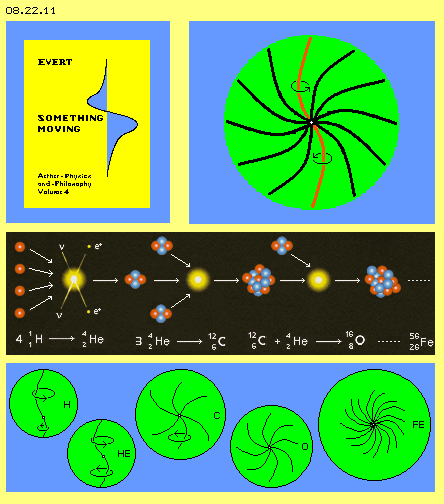 However now it´s a question, how motions could function within that gapless medium at all. The motion pattern of an electron (see upside right at picture 08.22.11) can show the general principle. At the outside face of a local object may not exist motion, in order to avoid conflicts with the ´resting´ aether of the environment. At the inner areas of an object all motions must balance mutually, in order to build a harmonious and stabile order. As no separated aether-´particles´ exist, a minimum local sector of that substance is called an ´aetherpoint´. Neighbouring aetherpoints are marked as ´connecting-lines´. At this picture one curved connecting-line is underlined by red colour.
However now it´s a question, how motions could function within that gapless medium at all. The motion pattern of an electron (see upside right at picture 08.22.11) can show the general principle. At the outside face of a local object may not exist motion, in order to avoid conflicts with the ´resting´ aether of the environment. At the inner areas of an object all motions must balance mutually, in order to build a harmonious and stabile order. As no separated aether-´particles´ exist, a minimum local sector of that substance is called an ´aetherpoint´. Neighbouring aetherpoints are marked as ´connecting-lines´. At this picture one curved connecting-line is underlined by red colour.
That ´double-crank´ (analogue to the crank-shaft of a two-cylinder motor, however well-rounded) is swinging around its longitudinal axle (see circle arrows). Momentary the aether upside is positioned some left and for compensation the aether further down must momentary be positioned some right. Within that gapless medium, all aether aside of must swerve correspondingly, here bended around the center (see black connecting-lines). So all aether is synchronous swinging, symmetrical to the center: from outside inward by increasing radius, further inward less far, while the aether at the center practically keeps its place. All motions are mutually coordinated, no part of that motion-unit can move independent. When building up such an object, the swinging motions must simultaneous increase at all internal regions same time. Opposite, the motions within such an aether-plasma-sphere merely can be stopped. That´s why electrons are lasting extreme long-lived.
Atom
At the middle of the picture a graph shows the common idea for building chemical elements inside of stars. Starting point is the most widespread element of hydrogen H. I guess it´s a variation of the electron motion-pattern, e.g. with some asymmetrical center (because most H-Atoms combine to a H2-molecule). If four of such vortex-complexes hit rather violent, they might ´stick together´ building a helium-atom He. If three of such motion-pattern are compressed very hard, they might build a carbon-atom C. If further two ´vortex-spindles´ crashed into that unit, an oxygen-atom O could result. Further attacks or fusions could insert additional vortex-spindles, resulting e.g. an iron-atom Fe as a wide cluster of aether-vortices.
At row below of that picture, the criteria of these elements are sketched schematic (as flat graphs of three-dimensional objects). The diameter of the elements is drawn true to scale, where e.g. that O shows a better order than the C and thus it needs less volume. Opposite to that rough sketch, additional vortices can sit on top of inner vortices. All around the center, radial arranged are double-cranks or multiple-cranks (corresponding to conventional idea of electrons swirling around at different layers).
So the atoms exist only by pure aether. The universe in total exists only by that unique substance. There is no need and no place for other ´materia´. There are only some local areas (opposite to the Free Aether called ´Bounded Aether´) with internal specific order. Towards outside exists a smooth transition to the ´resting´ Free Aether. Inside the atoms differ only by the complexity of their motion-structure. Inside however won´t exist any ´elementary particles nor sub-elementary particles´. There is only a coherent swinging. Especially at narrow space of the core, all motions must coordinate exactly. That´s why the atom-nucleus seems hard, massive and heavy. Common quantum-physic believe in ´quarks´, assuming these would be ´particles´, even when existing only for mimimum moments. In reality only track-sections of internal aether movements are detected, which quite naturally are steady merging form one shape into an other at the observed place. If e.g. at CERN some ordered motion-structures of ´particles´ are fired against each other, only motion-waste can result (which has no inner order and thus is rubbed off immediately by the aether-environment). It´s most strange to believe one could detect by crash-tests ´what is keeping together the parts of this world´.
Einstein-Aether
The idea of ´light-aether´ failed because one problem could not be solved: how could ´solid materia´ wander through a medium of most strong density? So one was very appreciated when Einstein ´eliminated´ the necessity for the existence of an aether. In late years however he corrected this understanding. Because these statement are rarely quoted, here once again the decisive passage of his speech at University Leiden in 5.5.1920: "In summary we can state: based on the general relativity theory the room has physical qualities; so by that sense an aether exists. Based on general relativity theory a room without aether is unthinkable; because within such a room not only the propagation of light would not be possible, but also would not exist the possibility for measuring-yardsticks nor clocks, thus also no spatial-temporal distance in physical sense. That aether however might not be assumed to have characteristic properties of ponderable media, thus it won´t exist by particles which one could observe in time; the term of ´motion´ can not be applied to the aether".
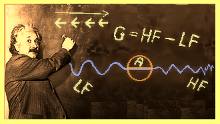 Not only ´based on RT´ but generally one needs 3D-space and time for description of physical processes. However these are only fictive measurement-standards and calculations, where e.g. the null-point can be positioned as we like it. If the space would exist by vacuum, in reality would still exist nothing. That´s why Einstein pointed out, only the existence of aether can give the (abstract) space the (real) ´physical quality´. Secondly he stated, the light ´naturally´ needs a medium for transmission (because, as stated upside, within Nothing can not move Anything). Third he stated, that medium can not exist by weighty particles like known media (but aether must be a coherent ´plasma´). Within ´normal particle-media´ (e.g. the air) losses are inevitable (so no energy constant can exist within). His forth statement is remarkable: the common term of motion might not be applied at the aether. No wonder that the contemporary physicists (and the present protagonists) ignored that message (and also Einstein himself could not explain plausible this aspect).
Not only ´based on RT´ but generally one needs 3D-space and time for description of physical processes. However these are only fictive measurement-standards and calculations, where e.g. the null-point can be positioned as we like it. If the space would exist by vacuum, in reality would still exist nothing. That´s why Einstein pointed out, only the existence of aether can give the (abstract) space the (real) ´physical quality´. Secondly he stated, the light ´naturally´ needs a medium for transmission (because, as stated upside, within Nothing can not move Anything). Third he stated, that medium can not exist by weighty particles like known media (but aether must be a coherent ´plasma´). Within ´normal particle-media´ (e.g. the air) losses are inevitable (so no energy constant can exist within). His forth statement is remarkable: the common term of motion might not be applied at the aether. No wonder that the contemporary physicists (and the present protagonists) ignored that message (and also Einstein himself could not explain plausible this aspect).
Motion through Space, Mass and Inertia
So what´s moving really? The answer is simple: all aether all times. As mentioned upside: as soon as any motion did come up, every surrounding aether is involved immediately. Within that plasma no motion can ever be stopped. However, everywhere is neighbouring aether, so an aetherpoint can move only minimum distances (if neighbours move accordingly) and every aetherpoint must finally come back to its original place. As a rule thus motions are possible only at minimum small circled tracks. Based on overlays, these are practically never exact circles, but spiral track-sections building three-dimensional ´motion-clusters´. A photon can move through the aether without resistance, because at front side exists anyhow a turning motion and only its radius must become some wider and at the rear side immediately the motion falls back to its normal narrow swinging. Manifold radiation are racing through the aether into all directions permanently. So also far outside within the universe, that ´Free Aether´ is steady swinging at narrow space and short track-sections.
Opposite the photon, an electron must not race through the space but can stay at its location. At the other hand, any impulse can push the electron forward. However there won´t move forward that ´electron-aether-volume´, but only its motion-pattern is displaced ahead within the aether. The aether in front is ´deformed´ into the shape of the electron-internal motion-structure for short moment. At the rear side, the superior strength of Free Aether forces the motions back into its original pattern (and thus is driving forward the electron). This temporary conversion to the complex pattern involves peripheral aether above the normal electron-volume (and that´s why that initial impulse for ´pushing the mass forward´ is necessary). If the electron is steady moving (without resistance within that real ´ideal´ medium), it shows inertia. When the electron hits onto other ´Bounded Aether´ (local motion-units like electrons or atoms), the inertia-power becomes obvious and effective as kinetic energy.
Opposite to simple electron, the atoms show vortex-structures much more complex. So much stronger impetus is demanded to transfer an atom from ´resting´ into moving status. At front of its way, much more aether-volume must be forced into new shape of motion. Based on its properties according to an ´Ideal Gas´, the aether won´t affect resistance when these ´vortex-spheres´ go on moving forward (however they represent corresponding stronger inertia respective they will affect with stronger kinetic energy).
There is no substance of hydrogen, helium, carbon, oxygen or iron, nor of any elementary- or sub-elementary-substance. Only one unique aether-substance is necessary within which are embedded local units with each specific motion-pattern (maximum these 5 % of all aether). The aether-volume has not more ´weight´ than likely wide volume of its aether environment. Everything exists by likely substance. No ´solid materia must struggle´ through the dense aether, no ´portions of aether´ are flying through the space, only motion-structures are forwarded through the aether. That´s analogue to sound: also there no air-particles are flying forward, but only that pattern of ´compression with following decompression´ wanders forward. Behind that longitudinal wave, all air-particles are at their old place.
So previous light-aether-dilemma is solved: also the earth is no ´solid chunk´ but only a huge assembly of complex vortex-units of aether within the aether. The earth is flying through the space, as all its motion-pattern are shifted forward. Quite likely, the passengers of that ´space-shuttle´ are shifted forward. However: why don´t we register the wind, when flying through that stationary aether (indeed, for long times one tried to measure aether-winds as proof for the existence of aether).
Sun-System
Picture 08.22.13 upside at A shows the sun (S), some planets and their speed within space (red curve). The ecliptic is a vortex-system and it´s border (WG) is assumed at about 10000000000 km. From outside inward the planets are moving faster (Pluto, Jupiter and Saturn e.g. with 5, 10 and 13 km/s). The earth is drifting forward with some 30 km/s. Mercury again is moving faster with an average of 48 km/s. That´s the characteristic of a potential-vortex: from outside inward faster rotating, concerning the absolute and also the angle-speed.
However the acceleration can not go on unlimited, because the equator of the sun shows a turning speed of only 2 km/s. So from Mercury inward the potential vortex must transit into a rigid vortex. Its characteristic is steady angle-speed, where the absolute speed is linear reduced towards the center.
Upside, the vortex-system of Milky-Way was compared with a huge flow of water. However, such spacious flows are impossible within that gapless aether. Neither at the outside border nor within the flow, the aetherpoints can ´scratch´ along each other (like it´s possible within a particle-medium without problems). If there can not exist extended aether-flows, however the planets are drifting around the sun, their draft must have an other reason. This decisive aspect for motions within the aether is sketched at second row of this picture.
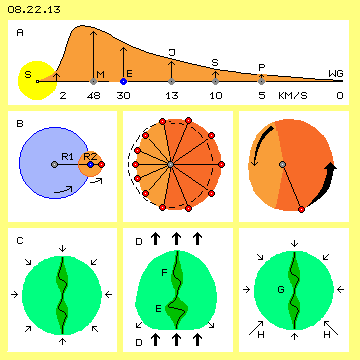 Swinging with Stroke
Swinging with Stroke
Simplistic one can imagine, all neighbouring aetherpoints are swinging parallel at circled tracks. Practically all times will exist overlays, like marked at this picture left side at B. Around a center (grey point) exists a turning motion (blue circle). At radius R1 exists a second turning with R2 (red circle). Both turnings are left-turning with likely angel-speed.
At second row at the middle are drawn twelve positions of the observed red point. Each time-unit it is running sections of differing length (see black lines). As often mentioned upside, inevitably come up phases of acceleration and deceleration. The aether is moving relative fast a relative long distance (marked dark-red), alternating with shorter sections (marked light-red) and slower motion. Instead of the original circle-tracks are resulting a dented section and an extended section. That motion-pattern is called ´track with stroke´ (marked by the strong arrow at right side of the picture).
Because all neighbouring aether must behave synchronous, an area with the motion-pattern ´swinging-with-stroke´ exists. Within the gapless aether, theoretical this will reach unlimited far into all directions. This pattern will be limited to a local area, only if the strokes occurs synchronous at a circle all around. Just this is the characteristic of the ´aether-whirlpool´ around the sun (and likely function the whirlpools of the galaxy and around other celestial bodies). At the outside border of the vortex-system exists no overlay, further inward the radius R2 increases (and the ´stroke-component´ becomes stronger), finally towards the center the R2-radius decreases to null (so e.g. within the sun remains only the steady turning of R1).
Thrust by Deformity
Each stroke-component within the sun-whirlpool is pushing forward each atom, and thus the earth as a whole. Spoken more precise, the motion-structure of each unit of Bounded Aether is relocated forward a little bit by each stroke. At previous picture 08.22.13 third row at C, schematic is drawn an atom (green face) and only one spiral connecting-line representing a radial vortex-spindle (dark-green).
The atom is compressed from all sides by the steady ´rattling´ of the surrounding Free Aether (see arrows). Only some hundred chemical elements withstand that pressure, because their internal motion-structures are balanced, well ordered and stabile. All atoms have a smooth transition to the Free Aether. Inclusive that ´aura´ the atoms probably are much wider than commonly assumed. The outside areas of atoms are elastic by some range. Only the center seems hard and firm because many vortices meet at narrow space.
The thick black arrows at D represent a momentary upward directed stroke within the surrounding aether. The atom below becomes dented. The spiral swinging there is compressed into longitudinal direction (at E, comparable with a spiral spring) and becomes corresponding wider. Because the internal motion-energy never can be stopped, the ´weak border´ below at both sides is some extended (see arrows). Upside of the atom, the stroke-component has an effect as if the aether would ´run off above´. So at F, the upside vortex-spindle becomes stretched and the contour of the atom becomes some more slim.
The very next moment, the stroke-acceleration alternates into the deceleration-phase, i.e. the surrounding aether now is swinging back much slower. Now the Free Aether can straighten out the atom into its original shape, especially the extended areas of below areas (see arrows at H). Internally also the different tensions of both ´spiral-springs´ become balanced, whereby the center (G) is shifted some upward.
Cranks and Spindles
The aetherpoints at the ecliptic-plane can show only minimum different behaviour from one neighbour to the next. Opposite, the swinging within the aether upside and below that plane can be reduced at relative short distance. One can imagine this overlaying swinging motion by example of a ´mobile´ hanging from the ceiling (see picture 08.22.14 at A and B): a (red) sphere is hanging at a thread and is swinging at a circle (by R2). Its (blue) suspension-point is also hold by a thread and it´s also swinging at a circle (by R1). The second thread upside is stationary fixed (grey point) at the ceiling (corresponding to ´resting´ Free Aether). Both threads represent vertical neighbouring aetherpoints. That connection-line is moving along the shape of a cone-jacket. Even the horizontal extension of the whirlpool might be huge, the vertical ´threads´ can be relative short. That´s why these formations mostly are lenticular flat.
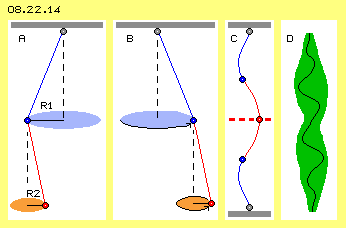 By the way: The connecting-lines represent neighbouring aetherpoints. However, within the aether exist no straight lines, but neighbours at curved lines are mutually synchronous swinging all times (see C). These swinging connecting lines upside and below the ecliptic-plane (red dotted line) build a huge ´crank´. Generally, that swinging is analogue to the tiny motions of a photon, an electron or the ´vortex-spindles´ (D) of atoms. Depending on the relation of the radius, the turning speeds and the turning-sense of overlays, the aetherpoints will move on most differing tracks. Thus even the gapless aether is a most extreme viscous substance, practically unlimited variations of motions are possible within. Even within a certain atom different variations of double- and multiple-cranks are possible, e.g. resulting the different isotopes of chemical element iron. Even beyond the physical appearances, the aether has a nearby unlimited ´bandwidth´ for swinging pattern of any kind (see below).
By the way: The connecting-lines represent neighbouring aetherpoints. However, within the aether exist no straight lines, but neighbours at curved lines are mutually synchronous swinging all times (see C). These swinging connecting lines upside and below the ecliptic-plane (red dotted line) build a huge ´crank´. Generally, that swinging is analogue to the tiny motions of a photon, an electron or the ´vortex-spindles´ (D) of atoms. Depending on the relation of the radius, the turning speeds and the turning-sense of overlays, the aetherpoints will move on most differing tracks. Thus even the gapless aether is a most extreme viscous substance, practically unlimited variations of motions are possible within. Even within a certain atom different variations of double- and multiple-cranks are possible, e.g. resulting the different isotopes of chemical element iron. Even beyond the physical appearances, the aether has a nearby unlimited ´bandwidth´ for swinging pattern of any kind (see below).
No Wind, no Inertia, no Attraction, other Mass and Density
The aether within a whirlpool differs merely from the aether outside of. Everywhere radiations and other swinging motions permanently are crossing, so everywhere exists a chaotic jumble like a ´wave-mash´. With concern to the atoms, that rattling of Free Aether is neutral. Within a whirlpool exists only a tiny overlay, likely directed all around the center. That constant one-sided influence is shifting all atoms into likely direction. The atoms of the earth are affected like the atoms of our body and also the air-particles all around. Each stroke is equally shifting forward all motion-pattern of all Bounded Aether - and that´s why we don´t register that process and no ´aether-wind´ is buzzing around the ears.
At last but one picture 08.22.13, the motion based on that overlay is most fast at right side and most slow at left side. That asymmetric stroke causes a prevailing ´left-spin´ within whole sun-system. The atom upside thus is not affected totally symmetrical: below right side the stroke is stronger and upside left the deceleration is greater. Thus the atom is stronger compressed below right and the depression works most easy upside left. The motion-pattern thus in not only shifted upward, but also a little bit turned-left, i.e. redirected into turning sense of the system.
The earth races around the sun by 30 km/s - however it does not show tangential directed inertia. Each single atom behaves like an ´amoeba´, which by de-forming and re-forming of its shape (inclusive its content) is shifted at circle track around the sun. If no tendency towards outside exists, no centrifugal forces exist, so no centripetal attraction is necessary for balancing. There is no need for mass-attraction. The fatal consequence: all calculations based on the idea of an universal gravity-constant concerning mass and density of celestial bodies are invalid and in vain. The sun is an accumulation of gases, however not compressed by urged gravity-power. The sun won´t content 98 % of all masses within sun-system. That ´pin´ is opposed by whole ´aether-masses´ of total ecliptic. Like the whirlpool as a whole, also the sun and all planets are build by just normal aether, so nowhere is concentrated any ´heavy mass´.
Whirlpool of the Earth
Analogue to the sun-system, the ´system-earth´ is also build in shape of a left-turning aether-whirlpool. The earth seems to be hard, however it is only an accumulation of atoms, thus a conglomerate of local vortex-clusters of aether within the aether. At picture 08.22.15 upside at A are marked some known data. The radius of the earth (E, blue) is about 6378 km and at the equator the surface rotates with some 0.5 km/s. At height of 35786 km the satellites (GS) must move by speed of about 3 km/s in order to keep their geostationary position. Up to that region thus the angle-speed is constant like at rigid vortices (WS).
At average height of 384400 km the moon (M) is drifting around the earth with its speed of only 1 km/s, each month nearby one revolution. Towards outside the absolute and the angle-speed is reduced, like at any potential vortex (WP). One can deduce the border of the whirlpool (WG) is somewhere at a radius of one million kilometer (like commonly is assumed the range of earth gravity effect).
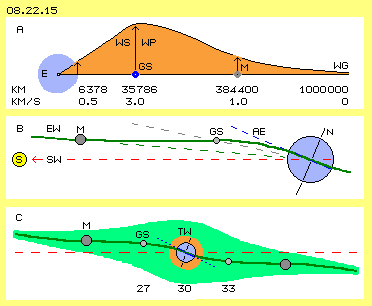 At the second row of that picture at B, the position of the sun (S, yellow) is far left and the ecliptic is marked by dotted red line (SW). At the night-side of the earth, the strokes of the sun- and the earth-whirlpools show into likely direction and thus they add without problems. At the day-side, the strokes are directed opposite. If two flows meet by opposite directions, the water won´t simply stop, but both flows will mutually get out of the way. Analogue, the (smaller) earth-whirlpool (EW, green curve) won´t rotate at the ecliptic-plane, but will swerve upward (at the day-side).
At the second row of that picture at B, the position of the sun (S, yellow) is far left and the ecliptic is marked by dotted red line (SW). At the night-side of the earth, the strokes of the sun- and the earth-whirlpools show into likely direction and thus they add without problems. At the day-side, the strokes are directed opposite. If two flows meet by opposite directions, the water won´t simply stop, but both flows will mutually get out of the way. Analogue, the (smaller) earth-whirlpool (EW, green curve) won´t rotate at the ecliptic-plane, but will swerve upward (at the day-side).
The earth-whirlpool does not swing at a plane level, but is shaped like a ´slouch-hat´. One symptom is the strange ´tumbling´ of the moon (varying versus equatorial plane between 18 and 28 degree). The moon does one revolution around its own axis each month (based on the upside ´amoeba-effect´) and he will be embedded within its own whirlpool (probably the reason for the ´spring-delay´, where the most high tides come up several days after new- and full-moon). The earth-whirlpool is also inclined somehow cross to the earth-sun-line (probably by 15 degree, resulting the delay of one hour of stabile positions of geostationary satellites).
The north-south-deviation of these satellites is smaller than that of the moon. Obviously the earth-whirlpool swerves into the equatorial plane (AE) only ´at last kilometer´ (see bended green curve EW). Below at this picture at C, the earth-whirlpool is drawn (cross-sectional) as a green face. Like at most galaxies, also that aether-whirlpool will be shaped lenticular. At the centre, the rigid earth is rotating steady. Up to the geostationary satellites the rotational speed differs up to 27 km/s at the day-side, however up to 33 km/s at the night-side. This is partly balanced by the inclination of the earth-axle (like also the sun-axle is inclined and there even the regions near the equator are faster turning than regions of higher latitude). At the other hand, these differences are causing permanent turbulences (TW, light-red) at near environment of the earth. Resulting are long vortex-threads (one calls magnetic lines) or a sphere-shaped curling-up, generating the free electrons of the ionosphere respective the negative charge at the earth-surface.
As mentioned upside, the track of the satellites (inclusive their deviations from exact geostationary positions) is resulting from the overlay of the sun- and the earth-whirlpool. The tracks of satellites and moons can be calculated by known (even false) formula, with sufficient accuracy. However all times come up any ´disturbances´ (at satellites of earth-orbit or at flight to the moon, to the sun or other planets). Within alleged vacuum, this can not happen ´voluntary´. So one should analyse all available data exactly - and will find the spreading of speeds (respective the strength of the ´stroke-components) within the whirlpools - and could make precise predictions for the tracks.
Gravity-Constant
However it´s a fact, an apple falls down from the tree - and that´s not to explain by previous whirlpool-model. Well known is the acceleration of a free falling body and which acceleration-force thus must exist at the earth-surface. Now it´s alleged, all masses mutually attract each other and - like at other physical ´fields´ - the strength of force correlates with the square of the distance. Thus one can deduce the mass of the earth. Because the known density of the earth-crust and known earth-volume is not sufficient, a huge core of melted iron must be implanted. For calculation with simple formula, the total mass is assumed to be concentrated at the earth-center (no matter that´s not possible in reality). The previous detected force of free falling body now is standardized to the gravity-constant of 6.67384*10^-11 m^3 kg^-1 s^-2 and it´s assumed, this would be valid universe-wide.
Well known is the volume of the moon and its speed, so now one can calculate also its mass and density. Based on known data of the earth, an analogue conclusion is possible concerning the density and mass of the sun, analogue also for other planets. If that formalism is extended to galactic level, however a multiple of masses would be necessary. Finally by including Dark Matter, the calculations seem consistent - or the general incorrectness of the applied approach becomes obvious.
Each apple falls from the tree. However at any location and at any time, different values of gravity are measured. That variable force may not simply be applied as universal gravity-constant, for calculations within the sun-system, the galaxy and up to the borders of space and time. Serious measurements e.g. did show, an aberration of gravity occurs each day one hour before sunrize and one hour after sunset, with differences in the scale of per thousand. Even the weather situation influences clearly the measurements. That´s clear evidence, the appearance of gravity is not depending on masses (they are constant at one location all times), but depends on the circumstances within the atmosphere.
Nervous and calm Aether
Upside, the aether was compared with water and driftwood within. As in reality only the substance of aether exists, a comparison with aether and ice would match better. Hydrogen and oxygen are gases, thus agile moving particles. As soon as they combine to an H2O-molecule, they take the physical state of liquidity. When building clusters, the water again becomes more viscous. If water gets could and frozen, the ice shows rigid structure. Between ice-chunks a transient state with slushy consistence of ´half-frozen soft-ice´ can come up. Correspondingly, the aether can also take states of different ´heat´.
The Free Aether (far aside of celestial bodies) is marked by overlays of all radiations racing through the universe. Each aetherpoint continuously is pushed to-and-fro into all directions. These hurried narrow motions are comparable with hot gas, where particles are pushed from one collision to the next by high speed. Hard radiations are filtered out at the magnetopause and also at the ionosphere many external ´disturbances´ get stuck. The aether there becomes much calmer, comparable with gas of normal temperature.
At the earth-crust, the radiations are mostly absorbed, the aether between the atoms calms further down (at previous comparison analogue to a liquid). Each atom has an aura, with a smooth transition between environment-aether and the atom-internal motion-pattern. The more narrow the atoms are positioned, the more likely the aether is moving within the atoms and between the atoms (a slushy consistence comes up). When atoms are arranged in shape of crystals, fitting motion-pattern build connecting ´bridges´ between (corresponding to previous ice-structure).
Further down within the earth one can assume the distinction of separated atoms gets lost, with a smooth transition all aether finally will take a state of ´plasmatical character´. Normally the atoms are compressed and conserved by the permanent pressure of the Free Aether. If down there the aether between the atoms no longer is nervous trembling and pushing, the internal motion-pattern of atoms can extend, i.e. all motions can smoothly combine into a swinging ´plasma-substance´. So deep down within the earth, well exists some ´molten materia´ - however null attraction-power.
As all aether is coherent, the ´calmness´ of the aether from the earth-crust is transferred also up into the atmosphere. At lower layers many air-particles are relative near to each other and the aether between can still be relative calm. Further up however, the Free Aether becomes increasingly more ´nervous´ by the radiations up there.
 Pressure-Gradient
Pressure-Gradient
At picture 08.22.16 left side, the character of Free Aether is marked by different swinging motions. Far outside, ´hot aether´ is trembling by nervous motions at short track-sections. Further below, ´calm aether´ is swinging on wider tracks. The speed of motions is likely everywhere (beyond light speed), only the tracks below are stretched wider (corresponding to Bounded Aether). At the atoms (light red) of the atmosphere from upside is rattling the nervous aether and affects a pressure at the upside face (dark-green arrows). Below of that atom, the aether behaves more conforming to its internal motions, i.e. the pressure (light-green) from below is gradually weaker than the pressure from upside.
As discussed upside by the effect of ´stroke-component´, also here the atoms are slightly deformed and the internal ´spiral-springs´(see curved connecting-lines, strongly overdrawn) are tensed different. That´s the reason, whey all ´material particles´ are shifted respective pressed towards the earth-surface. At previous photomontage, Einstein explains the gravity by the pressure-gradient between high and low frequencies of aether swinging motions. He well did know, the conventional term of movement can not be applied to that special medium. However he had no time to detail the different swinging motions of the aether (so at upside picture, I did put these words into his mouth).
Earth-Gravity
Right side of that picture, a graph shows the consequences, upside right however at first the common understanding of gravity (GK). Starting from the earth surface the force becomes weaker by square of the distance (see red face) and theoretical the force reaches out unlimited far. The atoms at the center of the earth are drawn into all directions, so their ´weight´ should decrease towards inward.
Second row shows the moon (M) which exists by materia like the earth, however the moon has no or only few atmosphere. The transition from ´hot to calm´ aether thus will occur at short distance. Pressure gradient (and thus the effect of weight) might start at only 10000 km height (and will end few kilometer deep at crystal stones).
Third row shows the sun (S) and comparable is the situation of gas-planets. The gases of these celestial bodies are not compressed by alleged attraction power, but are a ´loose assembly´ of gas-particles with a broad layer of atmosphere. The density within the gas-shell is softly increasing from outside inward and corresponding small are the pressure gradients within. Resulting gravity-effect could start at 50000 km or even only at 5000 km height.
At row below the earth (E) is drawn, which is surrounded by different spheres. The magnetopause reaches out about 600000 km at the night, but is compressed by strong sun-radiations (thus during the day) down to 60000 km. At these heights the hard radiations are filtered off and in addition some below at the ionosphere (also at varying height). Below of that range, the ´calming-down´ of Free Aether goes on at the atmosphere (however only down to some hundred kilometer to the ´transition-zone´, see green curve). Depending of the ´weather-situation´ the pressure-gradients are varying in differing height, (e.g. also before sun-rise and after sun-set, when the sun-radiation affects cross to the normally radial pressure-gradient). The earthly gravity can start at its best up at the magnetopause, most probably however below the height of geostationary satellites.
These satellites are drifting pure passive within the whirlpool of the earth. Only the satellites flying deeper must move faster (than pushed forward by ´stroke component´ of their height). These satellites (with relative speed versus the whirlpool) show inertia into tangential direction, which is compensated by the centripetal thrust of the pressure-gradients up there. By exact observing the ´disturbing influences´ at the tracks of all satellites (and comets) the understanding of the (varying) gravity-power would become realistic (instead of common fictions).
The enormous consequences of these considerations and insights are: it does not exist an universal wide attracting force between masses (how could it ever work within suggested vacuum). There is no locally concentrated ´mass´, because everywhere exists likely aether (and it is most strange, finally now one tries to explain the property of ´mass´ by the asserted detection of ´Higg´s-particle´). The atoms show different complex vortex-structures (even by likely volume). Their ´bulky resistance´ versus acceleration / deceleration results different inertia (based on the volume and complexity of temporary deforming of motions within the aether). Analogue comes up the appearance of different ´weight´ of atoms, depending on the complexity of their internal structure (because previous pressure-gradient ´weights´ on each vortex-spindle). So there is no attraction at all and even no ´gravity-constant´, uniform valid for all celestial bodies. The strength of gravity and the range of their affecting is individual for each celestial body, depending on its internal structure and of its external atmosphere. Only at the earth, the apple falls down from the tree by known data - and even these are differing at any time and any place.
Gravity at Garden-Pond
Because the idea of earthly gravity is quite novel, I´ll try to explain it once more by (nearby) comparable example. Sometimes my garden-pond shows explosive breeding of tiny biological organism. For the most part they exist by water. Also their structural framework and shell must show similar density, because they hang at all depth equally spread. The water is murky und nearby opaque. Finally when it starts raining, the water becomes clear and transparent down to the ground.
Rain-drops are falling onto the water-surface (comparable to the radiation running towards the earth). A deepening is pressed into the surface and pressure-waves are running radial into all directions (see picture 08.22.17 upside). The water is not compressible (like the aether), nevertheless tiny motion-pattern of pressure-waves are running through (e.g. like the sound). A great part is running horizontal or slightly directed down. So at upside layers of the water exists a ´jumble´ of motions (comparable to the protecting barrier of magnetopause and ionosphere). Partly the pressure-waves are directed down, however they spread and thin out in deeper layers (see straight lines). Down there the water is more calm (comparable to the Free Aether at the atmosphere). That difference of ´rushing´ affects a downward directed pressure (like the pressure-gradient of different aether-layers). The pressure-waves are running through the water and also through the water-part of these particles. The tiny water-movements however get caught up at the structure-grid of the organism, shifting them down (and likely the pressure-gradient within the aether is affecting onto the vortex-structure of atoms). Finally all suspending-particles gather at the ground (where pressure-impulses now appear as ´weight´).
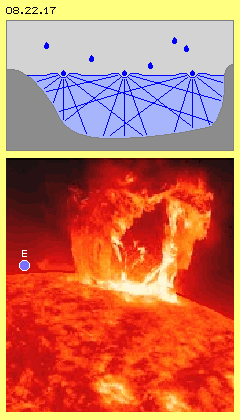 Within that ´coarse-matter´ tank of water, thus the rain produces an gradient from nervous to clam motion-layers, causing the particles sinking down. Similar layers exist within the aetheric environment of the earth, causing the earthly gravity. However that calming-down of aether-movements goes on within the earth-crust. Each atom has an aura and the nearer the atoms are, the less aether exists at the space between. That remaining Free Aether becomes adapted to the ordered swinging of neighbouring atoms, thus looses the nervous character. Heat wanders toward the cold, opposite is valid, the coldness spreads into previous hot regions. The calm motions of the Free Aether down there, thus spread upward, until the regions of the atmosphere. Based on local structure of the earth-crust and depending on ´weather-conditions´ (up to the magnetopause), determines the gradients from ´nervous to calm´ aether-movements. Thus gravity-acceleration is never constant, but locally and temporary variable - and once more different at other celestial bodies.
Within that ´coarse-matter´ tank of water, thus the rain produces an gradient from nervous to clam motion-layers, causing the particles sinking down. Similar layers exist within the aetheric environment of the earth, causing the earthly gravity. However that calming-down of aether-movements goes on within the earth-crust. Each atom has an aura and the nearer the atoms are, the less aether exists at the space between. That remaining Free Aether becomes adapted to the ordered swinging of neighbouring atoms, thus looses the nervous character. Heat wanders toward the cold, opposite is valid, the coldness spreads into previous hot regions. The calm motions of the Free Aether down there, thus spread upward, until the regions of the atmosphere. Based on local structure of the earth-crust and depending on ´weather-conditions´ (up to the magnetopause), determines the gradients from ´nervous to calm´ aether-movements. Thus gravity-acceleration is never constant, but locally and temporary variable - and once more different at other celestial bodies.
Gravity at Sun-Surface
Glancing at the sun, euphoric Feynman could have enthused: ´who does not feel the attraction of sun, has no soul´. Young Einstein would have stated: ´who does not recognize the curvature of space-time, has no ability for imagination´. Admitted, I can not imagine time-space nor their curvature (and I fear, also Einstein didn´t). Both should have imagined the earth positioned directly at sun-surface (see picture 08.22.17, below) - and by which vehement force it would be attracted and immediately disappearing into the sun. Opposite, gigantic ´flares´ (with multiple earth-masses) shoot off the sun, hanging around for days, before sinking down slowly.
So that suggested attracting gravity-force can not exist. In reality, around the sun are gathered loose gases, only gradually denser towards inward. Much stronger density-differences exist within the racing storms up there. The gradients of ´hot and cold´ aether (and in addition the alternating densities within these turbulences) are totally different form these at the earth. It´s absolutely un-imaginable, the working forces could be based on a common (universal-wide valid) ´gravity-constant´ (for details see ´Something Moving´).
Spiritual Worlds
Coming back to Feynman: he was an agile man and developed smart conceptions, explained these with great eloquence, truth and false with likely enthusiasm. When he died in 1988, his last words were: ´I´d hate to die twice, it´s so boring´. Like many others, he probably was rather astonished, his soul with all senses was still sprightly alive, now only as an ´aetherical entity´. He soon might have realized the ´essence of aether´. He had fun at the material world and probably he incarnated already once more. So it would be no wonder, if soon a ´young wild guy´ whirls up the physic-scene once more.
Feynman would forgive me that joke, because it touches an essential aspect: everything we call spiritual-mental-soulful is reality for us, has real effects. That can´t work only ´anyhow-nebulous-abstract´ but must be manifested as real as what we call physical-material-existing. As mentioned upside, that aether has an unlimited capacity for storage of numberless motion-pattern, which we ´realize´ as most different appearances, physical like emotional. Practically all old wisdom-doctrines tell it exactly: all is one.
Rupert Sheldrake e.g. often has proved, information respective knowledge is available at far distances via ´morphical fields´. That´s only possible, if stored quite real within omnipresent aether and available by corresponding focus. For example, the atmosphere within a football-arena is ´loaded´ by thoughts and feelings so strong as if one could ´grab by hands´. There are numberless examples approving, that ´spirit´ has real affects on ´materia´ (vice versa). ´Everything is bound to anything´ is not only an esoteric or spiritual creed, but real reality: all is indeed bound directly to everything, because it functions exclusive within the unique medium of that aether.
That aether-worldview reaches far beyond previous phenomenon of dancing satellites. Besides the physical appearances it has a philosophical dimension and - if one thinks about more intensive - also ethical consequences. Such statements might produce a surge of emotions for some readers (visible at the ´aura´ for some people). The mind of most readers however instinctive refuses even to doubt at its old knowledge (because the mind for itself is responsible for fast decisions by empirical judgement within the material world). Probably however the strict logic and clear evidence of the aetherical worldview could stimulate to think about (or to study in detail that ´Something Moving´ at my website respective book).
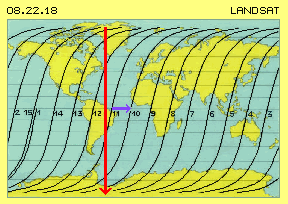 Earth Observation Satellite
Earth Observation Satellite
Actually I had finished that subject of ´Dancing Satellites´. Out of sheer curiosity, I searched for other satellites with strange appearances on the internet and straightaway made a strike: satellites for earth observation are dancing even more fantastically. This example shows some aspects once more even clearer, so I had to add this ultimative proof for the existence of the aether.
Picture 08.22.18 e.g. shows the tracks of a ´Landsat´-Satellite: one revolution takes about hundred minutes, so it rotates nearby fifteen times each day. In this picture, the satellite flies from north to south (red arrow) and below it, the earth is moving from west to east (blue arrow). The satellite ´scans´ the earth surface along an S-shaped track (much distorted on that ´right-angle map´). As the satellite is guided on a sun-synchronous orbit, it takes the pictures of a region at the same hour every day. This allows comparisons between the seasons or years.
In picture 08.22.19, it is roughly sketched how to achieve that procedure. The earth (blue) rotates around the sun (S, yellow) once a year. Here, the earth is drawn at four positions, each by view onto the North Pole (N). At A, the satellite (SA, red) is moving upward over the North Pole. Below the satellite, the earth is turning anticlockwise (see circle-arrow).
The inclination of the earth-axle shows into likely direction all times, also when the earth did move from position A to position B. Theoretically, also the track-planes of satellites show into likely direction all times. If however the track-plane should be directed cross to the sun all times, it must also be turned left by 90 degree (see blue and red arrows at B).
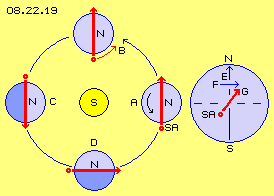 Sun-synchronous Orbit
Sun-synchronous Orbit
At C, the sun-synchronous track is drawn. The left side of the earth is in the shade (dark-blue), the right side (light-blue) is illuminated by the sun. The photos are made in the morning or the evening, where they have the most contrast by flat light (and e.g. also the heights are visible by the lengths of shadows). If the track-plane is shifted by one degree every day, it keeps directed cross to the sun all times (so also at D).
Right side of this picture, the earth is sketched by side-view and how that left-shift of the track-plane is done. The satellite may not be shot off directly from south towards north (black arrow E), but the satellite must be started with a forward-component (blue arrow F), thus the satellite must be launched diagonal (red arrow G). Actually each missile already has a turning momentum based on the earth rotation at its launch station. Mostly the satellites are primary shot into a ´parking-orbit´ and from there they are navigated into the finally demanded track.
The satellite on the one hand shows inertia, on the second hand the gravity affects concentric to the earth centre. So the satellite is bound to a stable circle-track (or mostly an elliptic track), no matter of inclination or height. It will fly over a wide circle and its track-plane will show into same direction of space. If here the track-plane should turn synchronous to the sun, each day it must be turned about one degree. If the satellite is running fifteen revolutions each day, the shifting is about 0.06 degree each revolution. That´s achieved if the inclination is 89.94 degree (so the angle between red line G and the blue dotted equator is rather overdrawn).
Gone with the Wind
So far the theory, however reality is quite different, however. In picture 08.22.20 upside left at A, a satellite is moving below the south pole (S) from back to the front of this picture. It is diverted towards east and crosses the North Pole by another direction (within space, thus related to fixed stars, irrespective to earth rotation). At B, the view onto the North Pole is sketched. The track sections in the southern half are marked by thin black curves and these of the north half by thick red curves. The satellite did move downwards below the south pole (in this graph, see black arrow). Also in the northern half, the track is still diverted eastwards. At each revolution the track-plane is shifted left-turning (by view onto North Pole). Here, two revolutions are marked and finally the satellite below the south pole is moving towards right (see black arrow).
The relations shown here are quite realistic, as marked upside right at C once more: when the satellite (SA, red) did 22 revolutions, its rotation axles (RA, blue) did turn once around the centre of the system. Theoretically, such tracks are stable within space. Such ´twisted rotations´ are not possible by school-physics (remember e.g. the reaction of a gyroscope when its axle is shifted). That combination of rotations is absolutely impossible by the laws of astro-mechanics (there are no planets or moons staggering around a centre like this). The official attempts at explanations are corresponding vague, e.g. ´the gravity-effect of the equatorial bulge´ might result in a turning momentum on the track-plane. One also tries to solve the problem mathematically, e.g. by formula wp=(3a^2/2r^2)*w*cos(i)*J2), where J2 is a ´coefficient of earth-development-potential´ with value of -1.083*10^-3 (please re-enact in your mind at the web, if possible). Such formula might result even usable values, however they never rebuild the real facts and causes. Opposite to these attempts, I state the simple formula W=360*0.7/2N as a true copy of real causes and everybody will understand without problems.
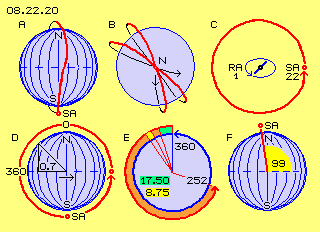 Blown away by Aetherwind
Blown away by Aetherwind
As mentioned before, the earth builds the center of an aether whirlpool (provisionally I´ll name an ´aether-wind´). Upside in picture 08.22.15, it was mentioned the whirlpool behaves like a rigid vortex from the height of geostationary satellites down to the earth, thus showing constant angle speed. At the equator, the wind is blowing so strong everything is shifted around by 360 degree every day. Opposite, it´s nearby calm at the center of the whirlpool, i.e. at the polar regions.
At this picture 08.22.20 below left at D, the earth (blue) is sketched by side-view. A satellite (SA, red) is moving below the south pole up to the equator (see red arrow), over the North Pole and down again to the south. Half of the time it´s moving in latitudes > 45 degree and is merely shifted aside within these calm polar regions. The second half of time, the satellite is moving between 45-degree-north and -south, where it´s affected by strong side-winds. By simple average, the sideward thrust is about 0.7 of the maximum strength of the aether-wind.
This picture at E shows a cross-sectional view through the equatorial plane. The earth rotates 360 degree every day (see blue arrow). That satellite is shifted forward by 0.7 of that force, thus each day only by 360*0.7 = 252 degree (see red arrow). A typical earth observation satellite takes about 100 minutes for one revolution, i.e. it does 14.4 revolutions each day. At each revolution it gets shifted eastward by 252/14.4 = 17.50 degree (marked light-green). The satellite is exposed two times to that sideward thrust: on its way from south to north and once more when moving down again. So at each section of its track it´s shifted by 8.75 degree (yellow). These facts directly are expressed by previous formula 360*0.7/2N (where N = revolutions/day).
On the web one can read most earth observation satellites are flying at heights between 650 km and 900 km, about 14 or 15 revolutions each day, so one revolution takes about 100 minutes, where the inclination is about 98 to 99 degree - perfectly according to previous simple calculation (see angle at F, marked yellow). So no dubious turning momentum based on alleged stronger gravity of the equatorial bulge is demanded. These satellites are simply pushed some eastward by the ´aether-wind´ of the earth-whirlpool. If the track-plane should keep its direction synchronous to the sun, that drift must be compensated. These satellites must be launched some against these west-winds and thus against the turning sense of the earth.
Opposed to the Wind
In picture 08.22.21, some data of satellites are drawn. The earth (blue) has a radius of 6378 km and 650 km higher, at radius of about 7000 km, the satellites (SA) are moving at sun synchronous orbit. There, the aether-wind is blowing by about 0.5 km/s. Six times higher, at radius of about 42000 km, the geostationary satellites (GA) are moving by about 3.0 km/s (also six times faster, because the aether-whirlpool builds a rigid vortex up and some beyond that height). The geostationary satellites must be launched by speed up to 10800 km/h (3.0*3600) into their orbit. Afterwards they are drifting within the aether-wind up there (completely embedded, without relative speed).
If a satellite flies at height of about 650 km and one revolution takes about 100 minutes, it must move by about 7.0 km/s. Only that remarkable speed of 25.200 km/h (7.0*3600) produces an inertia corresponding to the pressure of earthly gravity (here marked only by one arrow GD), so the satellite is forced into a circled track. The demanded thrust depends on the flight direction: if the satellite should rotate at equatorial plane into turning sense of the earth, a launch-speed of 6.5 km/s will do (because the wind contributes its 0.5 km/s). If it should fly contrary to earth-rotation, if must be accelerated up to 7.5 km/s (because opposed to the aether-wind of 0.5 km/s). If it should fly at a polar orbit, if must be started by exactly 7.0 km/s into S-N-direction (and afterwards it will go on flying at the ´twisted´ track marked upside in picture 08.22.20 at B and C). If it should move at sun-synchronous orbit with an inclination of e.g. 99 degree, it must be started partial faster (e.g. with about 7.05 km/s).
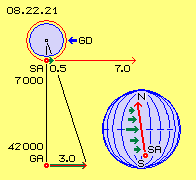 So once more it´s clearly evident: first, an aether must exist and second, it builds a whirlpool around the earth. However, it cannot be an aether of any kind (like most authors use or misuse that term without clear definition). The aether is the unique real substance with the unique property to be a partless and gapless and incompressible whole. That´s totally in contrast to our experiences within the ´material world´. However, just this property is approved by the behaviour of these satellites.
So once more it´s clearly evident: first, an aether must exist and second, it builds a whirlpool around the earth. However, it cannot be an aether of any kind (like most authors use or misuse that term without clear definition). The aether is the unique real substance with the unique property to be a partless and gapless and incompressible whole. That´s totally in contrast to our experiences within the ´material world´. However, just this property is approved by the behaviour of these satellites.
Right side below in this picture, the earth is drawn by side-view. A satellite (SA) flies from south to north with an inclination of 99 degree (red arrow). From below up to the equator, the west-wind blows increasingly stronger and upside of, it becomes weaker again (see different green arrows). Correspondingly, the satellite is diverted to an S-shaped track. In total however, its track-plane is stationary within the space respective directed all times cross to the sun (if each day adjusted by one degree, like discussed upside).
That journey is comparable with an airplain opposed to side-winds or to a ship travelling in crossing currents. They need steady thrust against the sideward flows, otherwise the speed of the vehicle is diminished. Up there in the ´aetheric regions´, the satellite needs thrust only until arriving at its orbit, afterward it flies without driving force on and on (Landsat-5 keeps the record with 29 years). That´s no problem for school-physics: within the vacuum exists no resistance (however, the calculations demand a vacuum filled up by 95 % Dark Matter and Dark Energy). By common sense, within nothing, nothing can be moving and any something (no matter which kind of particle) would immediately disperse into surrounding nothing.
So there must be a plausible explanation for constant speed despite of disturbances. That problem is similar to the beer-glass-phenomenon (which also is not to explain by common understanding of physics): a light ray with its speed of 300000 km/s becomes decelerated when crossing the glass, is running only by 2/3 through the beer, is moving faster again through next glass, finally flying off through the air by its original speed of light (see chapter 04.03. of my Aether-Physics).
Energy, Fields, Forces
Energy is actually nothing else than aether motion. What previously is named by the abstract term of ´physical fields´, also are concrete motion-pattern. Only real motions can have an effect on other motion-pattern (e.g. magnetic fields onto circuit lines or the general aether-pressure affecting equal spreading of charge at conductors). Here, three forces are relevant like shown in picture 08.22.22 schematic: gravity-pressure (A), whirlpool-thrust (B) and inertia-power (C and D).
Opposite to the fictive idea of an universal gravity in shape of attracting forces, upside at picture 08.22.16 was explained why the pressure-gradient is caused by different characteristics of aether motions. Left side at A that symbolic diagram is repeated (detailed upside or in chapter ´08.16. Nature or Gravity´ on my website or in my book).
In the middle of this picture at B, the ´stroke-component´ of whirlpools is drawn once more (detailed upside in picture 08.22.13 respective in chapter ´08.17. Aether-Vortex of the Earth´ on the website or in the book). The overlay of two simple circled motions already results phases of accelerated motion alternating with decelerated motion. The stroke deforms the atoms and when they regenerate, their centre is located a little bit forward within space. So there is no wide flowing ´aether-wind´ (as simplistic used upside). On the other hand, because neighbouring aether-points must behave synchronous, that motion-pattern around a center can extend to ´galactic´ dimensions.
 Inertia, Mass, Energy-Constant
Inertia, Mass, Energy-Constant
Upside right in this picture at C, the ´inertia-field´ of an atom is now sketched. The internal complex of vortices is marked by dark-grey circle face. Around each atom, an ´aura´ exists with balancing motions as a smooth transition towards the surrounding Free Aether. Like the earth-system is much wider than the earth by itself, also a (resting) atom inclusive its aura is much wider than commonly assumed. If now that atom is moving forward, the aether at its frontside (temporary) must take the motion-pattern of the atom. At the frontside, the narrow motions of Free Aether become enlarged to the wider motions of the atom-vortices, afterward the surrounding aether falls back into its original shape of motions.
The atom affects a (deforming) pressure at the frontside, which spreads into the environment. This aether however has no gaps anywhere and also it´s not compressible. The aether pushed off forward and aside at frontside, can not escape in any direction - only behind the atom it can move back to its old place. Thus around an atom and its aura comes up additional motion. The general principle is marked by curved arrows within that light-grey area (where in reality the motion are not running straight line from the frontside to the rear end, but are spirally twisted, e.g. analogue to a photon, see upside). In comparison to a resting atom, much more aether-volume is involved by the moving atom, which (by that sense) shows increased ´mass´. That atom carries along an additional ´inertia-aura´. The faster the atom is moving, the more extended becomes its total motion-volume. When that atom (inclusive its surrounding motion-structure) is decelerated, the kinetic energy becomes obvious in shape of affecting mechanical force.
Whoever did stroke a foot-, tennis- or golf-ball, temporary did deform atoms and gave them a forward-impulse and thus increased their ´aether-volume-masses´. Already in flight, each air particle affects resistance, reducing the velocity. Above at airless space, the speed keeps constant. However, that´s only possible if the deformation pressure at the front side of the atom is transferred into thrust pressure at the rear end of the atom without any loss. Theoretically, this is only given within an ´Ideal Gas´ - and just these properties in reality are given, if and because the aether actually is a gapless entity universe-wide. The theorem of energy-constant is only valid within that really part-less medium.
Constant Inertia at changing Directions
If the previous ball is affected by a gust aside, its flight-track changes and behind the gust it will fly into another direction. In the previous picture at C, an atom of previous satellites is drawn. The ´aether-gust´ at the equator affects sideward thrust onto the atom. Later however and most astonishing, the atom goes on flying into its original direction. The ´swinging with stroke´ occurs synchronous in the whole area (here represented by only four symbols of asymmetric circled motions). With each stroke, the atom by itself plus the ordered motion-structure of its ´inertia-shell´ is shifted a little bit to right side (see thick arrows). The following phase of slowly swinging back (see thin arrows) takes just likely time, so the whole motion-complex has enough time to regenerate into its original shape. When the sideward disturbance becomes weaker or ends (in polar regions), that atom will go on moving by its original inclination degree.
These temporary strokes of aether-whirlpools thus affect a relative soft push (nevertheless driving planets around the sun and moons around the planets). Other ´fields´ respective other motion-pattern show other effects onto atoms. As an example, below right side in this picture at D, a graph shows the effect of earthly gravity onto the atom and its inertia-shell.
This atom is a part of a missile launched diagonal upward. Already at climbing phase, the flight track becomes bended towards the earth, i.e. the vector of inertia is redirected some more horizontal (see dotted green arrow). When flying at the orbit, the vector is steady shifted into tangential direction (by subtle steps, nevertheless by 360 degree each revolution).
Opposite to previous whirlpool, the motion-pattern of gravity diverts the direction of inertia of each atom and body. In outer space, a steady rush of ´hard´ radiation exists (short waves respective high frequencies) towards the earth, appearing like a ´static´ pressure (in comparison with the soft pulsating thrust of whirlpools). From below, the earth sends off ´soft´ pushes (e.g. long wave heat radiation). The local gradient between downward and upward pressures (represented here by dark-green und light-green arrows) is shifting down all atoms. An upward motion within the inertia-shell (marked by thick black arrow) is hindered stronger than motions into other directions. That´s why the inertia-shell is tilted into a tangential direction, until the whole motion-complex of the atom is directed symmetrically to the radial affecting gravity pressure. Instead of the commonly ´shallow´ term of inertia, the appearance and interferences now are well founded by real aether movements.
Confusion, Unravelling, Perspective
Many readers might be confused by that appendix to the appendix for ´Dancing Satellites´. This might be based on my longwinded descriptions and explanations. At the other hand, it´s rather easy to talk about known stuff and it´s rather hard to talk about quite new aspects - and thus also to read and understand. These satellites at polar orbits or nearby polar orbits are a work of man (natural dust or bodies crossing a whirlpools soon are pressed into their planes). Just these artificial objects, however, made once more obvious which kind of motion-pattern represents which appearance and how different pattern are mutually interacting. Behind abstract terms (like field, mass, inertia, force and energy) now totally concrete motions of the totally real aether got visible - however only showing these inevitable consequences as a gapless whole.
If one obeys only the symptom-level, one needs different ´emergency measures´ for explanations (here e.g. that additional attracting force of equatorial bulge, there the Dark Matter as a whole). If one focuses the aether-background, only few restrictions of motions are valid. One must obey only some general rules for explaining lots of appearances likely. Unsolved phenomena can be founded by stringent logic.
A better understanding of basic processes behind the material would allow to construct machines more effective. Here for example, it would make sense to check the interference between inertia-shells and other motion-pattern, e.g. electromagnetic ´fields´ etc. As now one can handle the appearance of inertia as a concrete object of aether motions, it should be possible to create or stimulate or manipulate it primary, so secondary the body enclosed follows that ´artificial´ inertia shell. This might seem strange, nevertheless some inventors did already demonstrate comparable solutions (however mostly by try and error, which now could be replaced by serious scientific research).
At other sections of sciences, the investigations could also be based on that new background-level and by sure would allow quite new insights and results. Above this, a better understanding of the relation between spirit and materia could improve social coexistence. So there is reasonable hope, that a new world view might open most interesting new perspectives.
Evert / 2013-12-15
| 08. Something Moving |